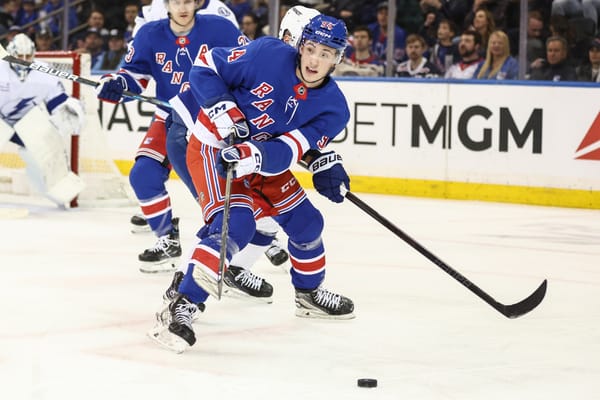Rangers, Shattenkirk at Unintended Crossroads
Why the veteran defender might be better off traded
In the approximately 16 months since his decision to sign with the New York Rangers — at a discount, no less — Kevin Shattenkirk has experienced just about everything go wrong that could go wrong.
Multi-game losing streaks. A front-office led rebuilding plan announced ahead of last year’s trade deadline and its corresponding liquidation sale. A season-ending knee injury that limited him to just 46 games in his first year and a coaching change upon its completion are all amazingly among the greatest hits on this record from hell for number 22 since joining the Rangers.
But surely none of this was in the plan for the then-28-year-old who explained as much during his first aired interview shortly after finalizing a four-year deal with New York.
”Really as much as it is a dream for me, it’s exciting. I’m looking forward to joining a team that I think is capable of winning the Stanley Cup,” an elated Shattenkirk said at the time.
As fate would have it, that team wasn’t bound for glory. Instead, it wound up in the scrap yard where it was stripped and sold for parts. All of which occurred just a little over six months from the day he signed.
Fast-forward to May and the Rangers have a new coach. David Quinn, who coached Shattenkirk when he played at Boston University between 2008 and 2010, and with the AHL Lake Erie Monsters, was brought in to replace Alain Vigneault.
For a while, things were good. It seemed Shattenkirk might even pose something of a model citizen for the Quinn era given his prior relationship with the new head coach. But fate had other things in mind. Again.
Less than a month into his first season, Quinn made Shattenkirk a healthy scratch for the first time as a Blueshirt, although his path to recovery after last season’s knee injury may have played a part in that. Moreover, Quinn’s staff also — knowingly or otherwise — forged the path for 23-year-old defenseman Neal Pionk to firmly usurp Shattenkirk’s place on the first power play unit — a decision directly attributable to Shattenkirk’s paltry production thus far this season.
There's some truth to this. Specificlaly the bit about the PP. In the last ten years he's scored just under 50% of his total points on the PP, so any dramatic cut in his opportunity there should, in theory, have a correlating effect on his total output, which we're seeing.
— One Sport Guy, Phil (@PhilKocher) November 27, 2018
Despite being among the leaders of all Rangers defenders in nearly every meaningful possession category — from game score (7) to relative corsi for percentage (3.72) to expected goals for percentage (51.41) — Shattenkirk’s mere 8 points in 27 games is rather easily explained by his lack of power play time this season.
Over the last ten seasons, in which he’s played over 1700 minutes there, few players have dined out on the man advantage as much as Shattenkirk has. Since 2009-10, he’s scored 329 points – 160 of which came on the power play. That rate of approximately 49% places him ninth among defensemen in that category over that time.
Yet this season, Shattenkirk has seen as his role as the first PP unit’s quarterback taken over by second-year pro Neal Pionk, who not only leads all Rangers’ defenseman by a mile in power play points (11) but is quickly encroaching on surpassing Shattenkirk for the team lead in power play minutes per game played. Pionk currently trails Shattenkirk by just 13 total minutes – a gap we can expect him to close in the next handful of weeks.
Shattenkirk’s on pace for just 24 points this year, which would just best his lowest-scoring season in 2012-13 — a lockout-shortened year in which he scored 23 points in 48 games. His points per game played (P/GP) rate, however, has never been as low as it is this season (0.30), which, detailed in a moment, is a direct result of his reduced presence as the team’s go-to power play quarterback.
Unsurprisingly, Shattenkirk’s P/GP has fallen by about half his career average, 0.58, this season. Remember that 49% figure mentioned just before? It sure seems awfully relevant here, no?
There’s no end in sight for Shattenkirk, either. Pionk has already surpassed him, as well as Brady Skjei and Marc Staal — the latter of whom is still inexplicably his even strength partner — for the team lead in total time on ice this year. Given the disparity between Pionk and all other Rangers’ defenders in power play scoring, barring a major dry spell, there’s little reason to believe Quinn and assistant coach David Oliver will reverse their roles any time soon.
This leaves Shattenkirk, already marred by sixteen months of disappointment, and the Rangers with awfully tough questions to answer as the clock ticks on what is likely another losing season, complete with a second-straight deadline liquidation sale.
Is all of this really worth playing for your favorite childhood team?
As Mike Murphy noted on the latest edition of Bantering the Blueshirts, sheep need shepherds. Perhaps he rather enjoys the idea of being a veteran leader tasked with bringing along a crop of young players expected to enter a contending window years from now. But isn’t that a job best suited for journeymen veterans or those who’ve already won before?
With two more seasons to go on his deal as he approaches 30, would Shattenkirk not be better-suited playing for a team far more likely to contend for a Stanley Cup in that time frame? Assuming winning the ultimate prize is his goal, of course.
A $6.65 million cap hit isn’t an easy one to move with so many clubs tight up against this season’s cap, but surely there’s a contender or two who would see the upside in dealing for Shattenkirk to bolster their respective blue line for a run at the Cup.
Would the Dallas Stars, for example, not see him as a sizable improvement to their right side that currently features Roman Polak playing a regular role? Shattenkirk would no doubt be a better point partner to Tyler Seguin than 24-year-old Gavin Bayreuther in John Klingberg’s absence, wouldn’t he?
Perhaps the Winnipeg Jets, now without top defenseman and PP staple Dustin Byfuglien (concussion) might seek a sizable insurance policy? Jacob Trouba is a fantastic defenseman, but with just 22 power play points in 353 NHL contests, a power play force he is not.
A return to the high-powered Colorado Avalanche would sure be fun. Shattenkirk could replace Nikita Zadorov at even strength on their right side, though it’s fair to question if the league’s best power play (32.2%) needs another weapon. Especially one that inarguably needs first unit minutes, which would likely result in bumping MacKinnon off the point and Colin Wilson off the ice for it entirely.
Lastly, though it’s probably a stretch to call them a contender, imagine him feeding one-timers to the recently returned Shea Weber north of the border in Montreal? Particularly after the failed Karl Alzner experiment.
Shattenkirk is the proud owner of a modified No-Trade Clause and a No Movement Clause (from 2018-20 per CapFriendly) in which he submits a 10-team no-trade list, so he controls a sizable percentage of his fate regardless of what the front office would like to do. But as the games — of which there are more losses than wins these days — continue to pass by, the 29-year-old ought to think long and hard about a destination change if he hopes to reprise his role as one of the league’s top power play QBs. Not to mention if his aspirations are higher than a shepherd.
It’s probably not going to happen on Broadway in the near future, and by most estimates, the Rangers team he agreed to join, now fully invested in the big picture rebuild, is approximately two years out from a serious run at the Cup. That would-be window opening would misalign with Shattenkirk’s trajectory like an episode of A Series of Unfortunate Events, just as he is set to hit free agency for a second time. This time at the age of 32.
There’s no rush to kick a highly-respected player out the door, but there’s also little reason to keep him around much longer as anything more than a highly-paid cheerleader. Through no real fault of their own, the Rangers and Shattenkirk are simply on individual orbits unlikely to align in time for either to capitalize on the other’s presence. Like a Baudelaire title drop, they’ve reached a proverbial crossroads that may be best served by an amicable divorce.
Data via Corsica.ca. Salary cap data via CapFriendly.com.




